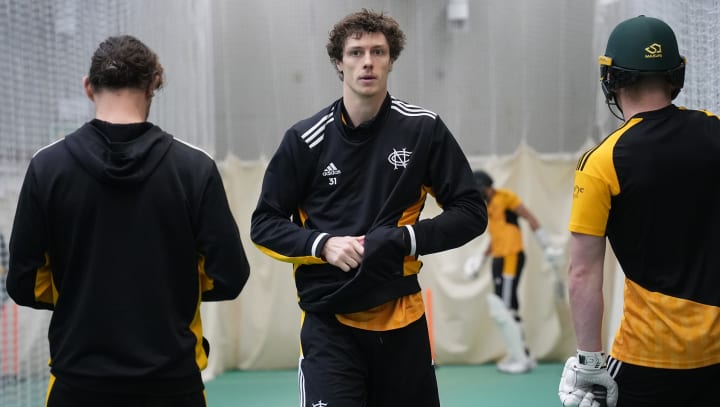In the second edition of Keeping up with Calvin, Harrison discusses the juggling act required to keep on top of his skills as an all-format all-rounder.
Having made his T20 debut with Notts in 2021 as a 23-year-old, he had to wait another two seasons before his First-Class bow for the club last summer, all the while remaining intent on making good on his goals of pursuing white and red-ball cricket.
Impressive performances followed in the County Championship as Harrison displayed hearty resolve with the bat - the likes of which was seen in a rearguard display against Warwickshire - contrasting his more attacking white-ball approach, while he returned 17 wickets with the ball.
******
Switching between formats provides a different challenge for everyone.
For example, a seamer goes from wanting to hit the top of the stumps more often than not, to a completely different set of skills with yorkers, slower balls, cutters, bouncers all thrown in.
For me, there isn’t as much of a difference. When I am bowling I am basically looking to do the same thing whether it is with a red or white ball. There might be a little bit of a shape change - I might bowl a bit flatter and shorter in white-ball cricket - but everything else is pretty similar.
The variations and deliveries I bowl more or less transfer across formats, it is just the regularity with which I bowl them which changes.
Because of that, I have focused more often on red-ball this winter, knowing that I’ll be able to transition to white-ball quite easily.
My main focus personally has been consistency. With regards to my red-ball bowling, I feel that I have been able to develop consistency that an orthodox bowler can bring and so, when needed, I have been able to tie up an end, and the variations of my leg spin also allow me to attack when appropriate.
This is a constant process of improvement and refinement so I can keep developing more strings to my bow. I think my ability to do that has come on a lot in the last few years.
I start all my sessions by bowling my stock ball for that reason. How the rest goes depends on a few things.
If we’re in a scenario-based net where I’m faced with a batter then I won’t look too much into hammering a variation - like bowling two overs of googlies - because that’s not realistic. I will try to draw them into playing certain shots with specific deliveries.
As players, we learn a lot from each other. If someone is driving non-stop, and then for one ball they check their drive and defend the ball, you ask what was different about the delivery - whether it was the flight, the length, the angle from the crease - that has made them act differently, so you can learn from it.
Other times my plan for a session will depend on what I've been thinking about the night before. When I get away from Trent Bridge, it can be hard to stop running through certain things in your mind. I’ll have a ball at home and will just flick it out my fingers to see what works and then come back in to try it in the nets the next day.
It would be good to switch off a little more than I do sometimes, but as long as it isn’t affecting my performance or getting to the point where I am overcomplicating things whilst I am in a game, then I don’t mind too much.
With the bat, there isn’t a massive amount of difference between formats, but there are a few technical things I try to feel for. My comfort at the crease comes from feeling relaxed from my elbow to my wrist and my hands flow in a nice path. Other than that I am just focusing on contact.
You are maybe more proactive against a white ball because you might preempt hitting a certain area before the ball has been bowled, whereas in red-ball cricket the delivery itself dictates the shot, but I definitely benefit from that positive mindset.
We mixed things up a little bit this week with a fatigue and masterclass session. We were able spend some time and volume on some specific batting skills which was handy. With the fatigue session, we had to run a two after facing every ball.
Off the back of a fitness session in the morning it was a test for us to nail our skills while under a bit more pressure and tiredness. It was definitely pretty tough, but I think everyone found it helpful and a good exercise to test ourselves in a different way to how we usually would.
It’s also nice to have a bit more experience under my belt. Against Warwickshire I got bounced out in the first innings, and they tried to do the same in the second. They had men back on the square boundary and a short leg, so I just had to prepare myself to cop a few blows. I’m sure it won’t be the last time that I’m tested in that way, but it was nice to come through it.
That is part of the red-ball game that it can be difficult to practice, so now that I’ve had a bit of time spending time in the middle in that environment, I can build on it.
The other part of the game is obviously fielding, which is something I was always told to take seriously. My dad was the coach of my junior team and we used to have sessions just for fielding, which was pretty rare. We won the league unbeaten that year, so I guess it worked! It was drummed into me that I spend the majority of my time fielding so I had to learn to enjoy it.
In the winter, it’s all about simplicity. In red and white-ball cricket, I field in a few places, from boundary riding to the slips, and through pre-season you just want to maintain that feeling of the ball hitting the middle of your palms, so it comes down to repetition.
Like with batting and bowling, my principles are the same in the field regardless of format. You have to be confident and want the ball to come to you regardless of its colour or the state of the game.
Read the first instalment of Keeping Up with Calvin here...
*******

